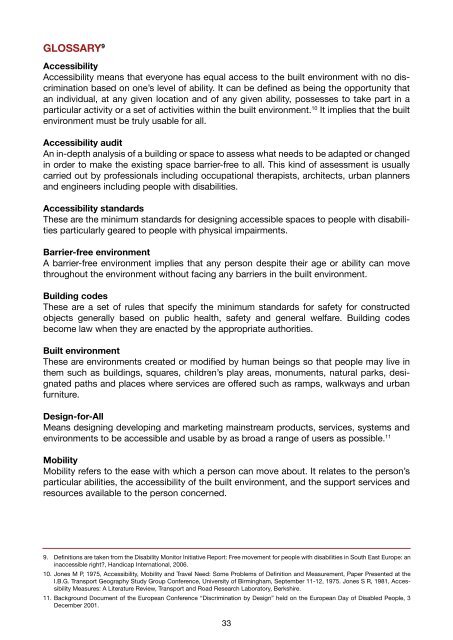Accessibility - Handicap International
Accessibility - Handicap International
Accessibility - Handicap International
You also want an ePaper? Increase the reach of your titles
YUMPU automatically turns print PDFs into web optimized ePapers that Google loves.
GLOSSARY 9<br />
<strong>Accessibility</strong><br />
<strong>Accessibility</strong> means that everyone has equal access to the built environment with no discrimination<br />
based on one’s level of ability. It can be defined as being the opportunity that<br />
an individual, at any given location and of any given ability, possesses to take part in a<br />
particular activity or a set of activities within the built environment. 10 It implies that the built<br />
environment must be truly usable for all.<br />
<strong>Accessibility</strong> audit<br />
An in-depth analysis of a building or space to assess what needs to be adapted or changed<br />
in order to make the existing space barrier-free to all. This kind of assessment is usually<br />
carried out by professionals including occupational therapists, architects, urban planners<br />
and engineers including people with disabilities.<br />
<strong>Accessibility</strong> standards<br />
These are the minimum standards for designing accessible spaces to people with disabilities<br />
particularly geared to people with physical impairments.<br />
Barrier-free environment<br />
A barrier-free environment implies that any person despite their age or ability can move<br />
throughout the environment without facing any barriers in the built environment.<br />
Building codes<br />
These are a set of rules that specify the minimum standards for safety for constructed<br />
objects generally based on public health, safety and general welfare. Building codes<br />
become law when they are enacted by the appropriate authorities.<br />
Built environment<br />
These are environments created or modified by human beings so that people may live in<br />
them such as buildings, squares, children’s play areas, monuments, natural parks, designated<br />
paths and places where services are offered such as ramps, walkways and urban<br />
furniture.<br />
Design-for-All<br />
Means designing developing and marketing mainstream products, services, systems and<br />
environments to be accessible and usable by as broad a range of users as possible. 11<br />
Mobility<br />
Mobility refers to the ease with which a person can move about. It relates to the person’s<br />
particular abilities, the accessibility of the built environment, and the support services and<br />
resources available to the person concerned.<br />
9. Definitions are taken from the Disability Monitor Initiative Report: Free movement for people with disabilities in South East Europe: an<br />
inaccessible right?, <strong>Handicap</strong> <strong>International</strong>, 2006.<br />
10. Jones M P, 1975, <strong>Accessibility</strong>, Mobility and Travel Need: Some Problems of Definition and Measurement, Paper Presented at the<br />
I.B.G. Transport Geography Study Group Conference, University of Birmingham, September 11-12, 1975. Jones S R, 1981, <strong>Accessibility</strong><br />
Measures: A Literature Review, Transport and Road Research Laboratory, Berkshire.<br />
11. Background Document of the European Conference “Discrimination by Design” held on the European Day of Disabled People, 3<br />
December 2001.<br />
33

















